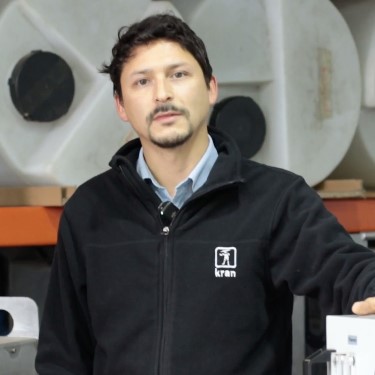July 30, 2024
Through nanobubble technologies, Kran seeks to improve water quality and production efficiency, achieving significant innovations ranging from effluent treatment to improved fish farming and wastewater recycling to optimize productivity and sustainability.
Since its founding in 2017, Kran has established itself in the aquaculture industry, through the use of nanobubbles, a technology that promises greater sustainability and efficiency in the management of liquid resources. The company has implemented innovative solutions ranging from improved influent treatment, which allows a notable reduction of metals and sediments in the water, to the optimization of fish farming, where nanobubble technology facilitates savings in oxygen and improves animal health. The company has also made progress in seabed recovery and the substitution of chemicals in plants, thus increasing the useful life of raw materials and guaranteeing food safety. In this respect, the manager of the company’s Aquaculture Division, Mauricio Bueno, said that “as a pioneering company in introducing nanobubbles to the Chilean aquaculture industry, we have dedicated ourselves to the continuous development of solutions based on this technology. This has resulted in having applications for the entire production chain in relation to processes where liquids are used, improving efficiency and sustainability, from the treatment of effluent to improve water quality (metals and sediment), to fish farming with oxygen savings and sanitary improvements; to then continue with marine service in mitigation and recovery of seabed where we operate in the three regions. We then move on to plants where we have substituted chemicals while maintaining food safety and increasing the shelf life of the raw material”. “In addition, we have several applications for wastewater treatment, in particular DAF systems and biological reactors that we have managed to make efficient and integrate quickly into the plants. These applications allow us to enhance the use of water used in the industry, resulting in lower consumption, efficiency in its use and reuse. In this line, the benefits or impacts are diverse, from the recovery of category 4 concessions with highly complex rocky bottoms, the reduction of up to 67% of peracetic acid in the plant, the extension of four days of fresh raw material quality and an increase of 30% removal in DAF systems”, added the executive. Mauricio Bueno also indicated that “in fish farms, the incorporation of our nanobubbles for fish oxygenation can be done from a header pond to increase basal oxygen, directly in the production ponds, replacing oxygenation cones, or even as oxygenation support to reduce the use of emergency diffusers. El punto de integración depende del tipo de piscicultura y de los objetivos definidos con el productor”. The point of integration depends on the type of fish farming and the objectives defined with the producer”. In this way, the company aims at innovation in oxygenation techniques that not only transforms water quality, but also creates a healthier and more productive environment for aquatic life, with applications ranging from headponds to emergency oxygenation support systems. With these advances, Kran continues to lead the way towards more efficient and sustainable aquaculture through innovation in oxygenation techniques that can radically transform water quality and promote a healthier and more productive aquatic environment for fish life.
SOURCE: AQUA.CL

